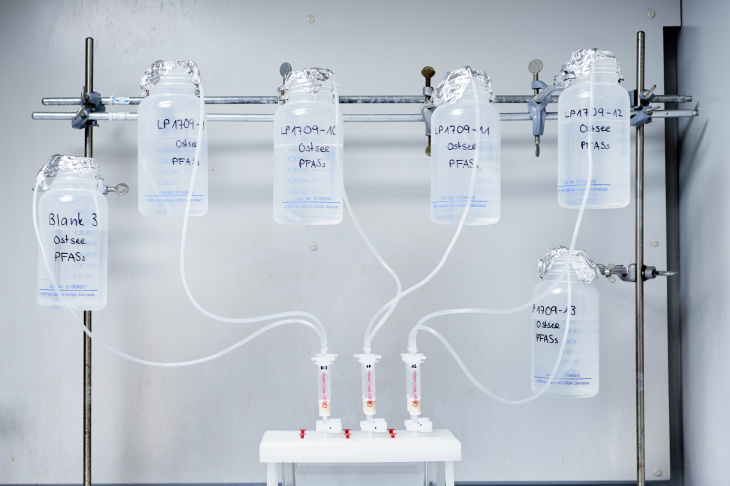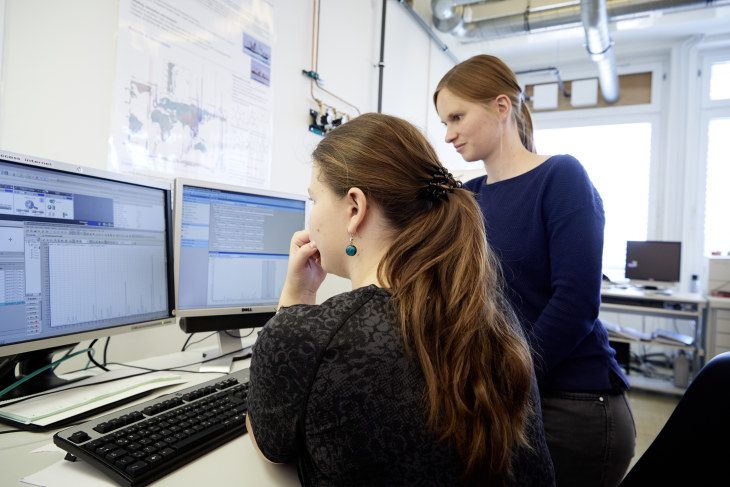Persistent organic pollutants
They are everywhere: from outdoor jackets, and disposable coffee cups to sunscreens. Many products found in our everyday lives contain chemicals that provide products with specific properties, such as water-repellence. However, in most cases the environmental effects of these chemicals are not well understood. According to estimates by the OECD (Organisation for Economic Co-operation and Development) and the European Chemicals Agency, humans are exposed to approximately 100,000 of such chemical substances. Approximately 1,200 of these are potentially persistent organic pollutants. They could be dangerous for the marine environment, the state of marine life and human health.

In the lab of the “Environmental Chemistry” Department. Photo: HZG/Christian Schmid
Researchers at the “Environmental Chemistry” Department of the "Biogeochemistry in Coastal Seas" division of the Helmholtz-Zentrum Geesthacht (HZG) are working to understand the environmental behaviour of persistent organic pollutants and to study the occurrence, distribution pathways and fate of these substances in the marine environment. Their research is also focussed on determining the extent to which changes in the production of many consumer goods used in everyday lives affect the prevalence and distribution patterns of these pollutants at the coast and in the sea. Scientists go on sampling campaigns using research vessels to take water and sediment samples from sites. They identify sources of pollution, for example at the margins of intensively developed coastal towns, and along transport routes to the coastal regions of the North and Baltic Seas. Such studies have been conducted in domestic waters as well as in the coastal regions of the Arctic and in China. The samples collected are then analysed in the HZG laboratories using state-of-the-art tracing techniques and equipment, in combination with detailed computer simulations.
New multimedia report on pollutants in the marine environment

Scientists Christiana Apel (left) and Hanna Joerss (right) wrote the multimedia article about pollutants. Photo: HZG/Christian Schmid
The data is then collated in a publicly available repository, the marine geoportal „coastMap“ of the Institute of Coastal Research. Data from the HZG research groups' field trips, and from their collaborative partners and projects are thereby centrally consolidated, with results presented in a format that is easy to understand.
The researchers Christina Apel and Hanna Joerss, two PhD students at the Institute of Coastal Research, have compiled the results of research carried out in the Department of “Environmental Chemistry” in a multimedia article. This process culminated in a report that explains the results in a comprehensible way that allows users to explore the data in interactive maps online.
Click here for the article focusing on “Persistent organic pollutants”
Background
Development of the marine geoportal “coastMap” was initiated by researchers at the “Biogeochemistry in Coastal Seas” division of the Institute of Coastal Research at the Helmholtz-Zentrum Geesthacht. Scientists at the Institute are investigating changes in coastal regions, specifically focussing on the continental shelf of the North and Baltic Seas.
Data and results from the NOAH-Project (North Sea Observation and Assessment of Habitats) funded by the Federal Ministry of Education and Research (i.e. the German “Bundesministerium für Bildung und Forschung” or BMBF) were used for the development of the portal. This project is one of twelve projects that constitute the “Coastal Research Agenda for the North and Baltic Seas” (i.e. the German “Küstenforschungsagenda für Nord- und Ostsee” or KüNO) of the central BMBF programme “Research for Sustainable Development” (i.e. the German “Forschung für Nachhaltige Entwicklung” or FONA).
Further Information
This is the sixth report in the series of articles on the coastMap portal. You can access the complete series here:
Contact
Head of the "Environmental Chemistry" Department of the Institute for "Biogeochemistry in Coastal Seas" at the Institute of Coastal Research of the Helmholtz-Zentrum, Geesthacht
Phone: +49 (0)4152 87-2354
E-mail contact